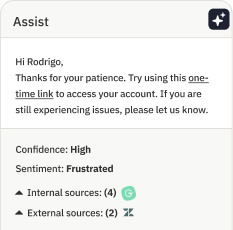How to talk to your team about adherence

Schedule adherence isn’t always an easy topic to discuss with your team. A lot of people see adherence monitoring as a form of micromanagement — one that leads to high stress and a perceived lack of trust and autonomy. But it doesn’t have to be that way.
Adherence is an incredibly powerful performance measure that ensures your customers get the support they need when and where they need it. And when communicated with honesty and transparency, adherence can empower frontline agents to take ownership of their contributions.
In this article, you’ll learn five practical tips to help you demystify adherence and get your team on board.
Set clear expectations
We tend to fear what we don’t know, so start by educating your team on how adherence contributes to the overall success of the customer support organization. The power of one is a great resource to help individual agents understand how being in the right place at the right time impacts customers and the entire team.
It’s important to set clear expectations around adherence — specifically the adherence metrics that agents should strive for. A common benchmark for support teams is 85–90% adherence; but like all KPIs, these goals should be tailored to your unique circumstances.
Keep in mind that, for teams that are new to adherence, 85–90% might be a little out of reach. Set realistic targets and continue working toward industry benchmarks quarter over quarter.
Ultimately, expectations should be clear, the impact of adherence should be well understood, and goals should be attainable.
Foster a supportive atmosphere and celebrate success
Adherence may be an individual measure of productivity, but it’s ultimately a team sport. When discussing adherence with your team, be sure to emphasize that the goal is to support the overall team’s performance.
Because there can be some anxiety around adherence, avoid singling out individuals or adopting a punitive approach. Let your team know that adherence shines a light on where there are opportunities for guidance and improvement. By focusing on growth and learning, you can positively reinforce a team culture in which adherence is embraced rather than feared.
Recognition programs and awards for individuals with the top adherence rates can go a long way toward getting your team excited about hitting or exceeding their goals.
Empower agents with information
In keeping with the theme of transparency, share adherence data with your team. Encourage them to take ownership of their individual performance.
In Assembled, individuals can see their adherence on the agent scorecard and track their progress daily. Many successful teams encourage their agents to monitor their own adherence throughout their shifts so they can see how they’re performing and where they could improve.
Bringing it all back to the power of one can help them understand why their individual adherence is good for the collective team.
Provide training and resources
Keep in mind that low adherence isn’t always a sign of poor work ethic. Many factors outside of an agent’s control can impact adherence, including insufficient training, complex customer interactions, poor time management, and unreasonably high occupancy. The more stressed and burnt out an agent is, the more likely they are to avoid work and perform poorly.
Take a proactive approach to addressing these risks by providing adequate training. When adherence is low, don’t assume — instead, get curious and ask agents if they can help you understand what’s preventing them from meeting their goals. Consider occupancy rates and adjust if the team is feeling generally overworked.
Adherence is typically about agent behavior, but there are many ways in which leadership can positively influence how the team performs.
Encourage ownership and collaboration
Keep adherence top of mind by scheduling regular one-on-one meetings to discuss adherence and other performance metrics. This will reinforce your commitment to developing members of your team while providing a forum for agents to ask questions, share concerns, and seek guidance.
Make sure it’s always a two-way conversation. Agents should feel empowered to suggest changes or improvements to the scheduling process or adherence monitoring method. By making adherence conversations more collaborative, you can promote a sense of trust and autonomy among your team.
Adherence is a team sport
These best practices for discussing adherence with your team will help you create a transparent and supportive atmosphere that fosters growth and powers team performance. Remember, the goal is never to micromanage — it’s to give your team the tools and understanding they need to show up for themselves and their team.





